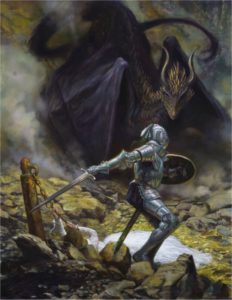 Elves, trolls, dwarves, goblins… There’s no denying that the Western fantasy is strongly entrenched in a Northern European mindscape: those ancient myths of the Celtic and Germanic people that inspired Tolkien and his epigones. Writing about elves and dwarves is always a safe bet; when an author wants to be original and adventurous, they might look into the myths of the Mediterranean: Greek, Roman, Egyptian. Sometimes we venture into the Far East, and populate our worlds with qilin and long dragons, or, even rarer, into India or Persia. This seems to be the farthest horizon of our inspiration. Beyond that is the weird territory, with creatures born out of the writer’s own half-deranged mind in an attempt at uniqueness – not that there’s anything wrong with that.
Elves, trolls, dwarves, goblins… There’s no denying that the Western fantasy is strongly entrenched in a Northern European mindscape: those ancient myths of the Celtic and Germanic people that inspired Tolkien and his epigones. Writing about elves and dwarves is always a safe bet; when an author wants to be original and adventurous, they might look into the myths of the Mediterranean: Greek, Roman, Egyptian. Sometimes we venture into the Far East, and populate our worlds with qilin and long dragons, or, even rarer, into India or Persia. This seems to be the farthest horizon of our inspiration. Beyond that is the weird territory, with creatures born out of the writer’s own half-deranged mind in an attempt at uniqueness – not that there’s anything wrong with that.
But the world is vast and old, and every culture has its share of strange and fascinating; there is a vast stock of ideas out there that you can tap into before running out of inspiration. In this series I will attempt to present some of these myths and legends. In the first episode, I tackle the mythologies of Western and South-Western Africa, a region stretching from Sahara Desert to the jungles of Congo, populated by a complex mix of cultures, nations, tribes and peoples descended from ancient Empires.
Vampires of Light
One of the most fascinating creatures of the West African folklore are the vampiric beings which, unlike their European counterparts, seem to have an affinity to the light instead of darkness. Take the Adze of Togo and Ghana: a blood-sucking, shape-shifting witch that transforms itself into a firefly. 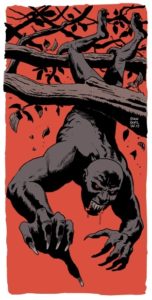 As a firefly, it can pass through closed doors and windows at night, and, after it turns back into a humanoid form, sucks its victim dry.
As a firefly, it can pass through closed doors and windows at night, and, after it turns back into a humanoid form, sucks its victim dry.
Or the Obayifo of the Ashanti, also known as Asiman in Dahomey: this vampire sorcerer travels as a ball of light, able to possess animals and humans. The possessed human shines light from its mouth, armpits and…other orifices; this doesn’t stop it from prowling in the night, searching for prey. The Obayifo is a powerful, malevolent spirit, causing blight to crops, withering fruit, and finally, sucking blood of humans. Like the Adze, the Obayifo have a special taste for children.
The Asanbosam is perhaps the most awesome and imaginative of the vampiric creatures: a great ogre with iron teeth and iron claws, hanging from trees, waiting for the prey to come below. Its kin, Sasabonsam, has huge, bat-like wings, is as tall as a tree and teeth sharp like spears.
Lost World
The tropical jungles of Congo and Zaire have, in local legends, been populated by a host of mythical, cryptid monsters, giving rise to the tales of the Lost Land where the dinosaurs still roam as if no extinction has ever happened. For the less imaginary Victorian explorers, these were all supposed to be real animals, remnant of the ages past.
There are benign ones, like the Ambize Angulo, or hog-fish – “so called because it is as fat as a hog, and produces lard”; and the fierce monsters, like the “breaker of boats” Kongamato – a red-and-black pterosaur with leathery wings and terrible claws. The Ninki Nanka is a dragon living in the swamps of Senegal and Gambia, while the Mokele-mbembe – “he who stops the flow of rivers” – is an elephant-sized creature with long neck and a small tail, Kongo’s distant cousin of Nessie.
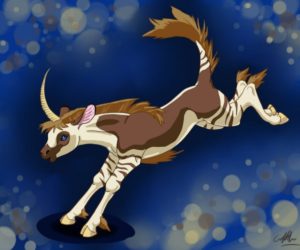 The pygmies of Central Africa live in fear of many-horned, rhinoceros-like monsters which were often assumed to be surviving ceratops: the six-horned Ngoubou, or the dreaded Emela-ntouka, “the slayer of the elephants”. The Congolese also speak of a smaller beast, a donkey-sized unicorn called Abada. Finally, there is the Nguma-monene, “great python” a 10-meter long, greyish-brown lizard with a ridge of spines on its back, so big that it hunts hippos, and its smaller, green, herbivorous cousin, Mbielu-Mbielu-Mbielu.
The pygmies of Central Africa live in fear of many-horned, rhinoceros-like monsters which were often assumed to be surviving ceratops: the six-horned Ngoubou, or the dreaded Emela-ntouka, “the slayer of the elephants”. The Congolese also speak of a smaller beast, a donkey-sized unicorn called Abada. Finally, there is the Nguma-monene, “great python” a 10-meter long, greyish-brown lizard with a ridge of spines on its back, so big that it hunts hippos, and its smaller, green, herbivorous cousin, Mbielu-Mbielu-Mbielu.
If you are in need of a really grand dragon-like creature, you could do worse than making acquaintance of the Rainbow Serpents – the God Serpents, Damballa and Aiya Weddo, present in myths of peoples of Benin, Dahomey and Nigeria, and, through Voodoo, transported into the Caribbean. These snakes took part in the creation of the world, and are mounts for the Gods – and when they ride out, they form rainbow in the sky.
Forest Fairies and Evil Children
The forests and jungles of West Africa are inhabited by a multitude of fairies and gnomes, most of which are either benevolent or, at worst, trickstery. The few evil ones usually take possession of children, either causing them to die from some wasting disease, or else misbehave and ruin their parents. The Emere of Yoruba culture are a sort of super children, who can travel between the worlds at will, are beautiful and powerful – the Elves of West Africa. The Abiku dwarves, on the other hand, also of the Yoruba, will eat and drink anything the child eats, and when it inevitably dies, it moves on to another victim.
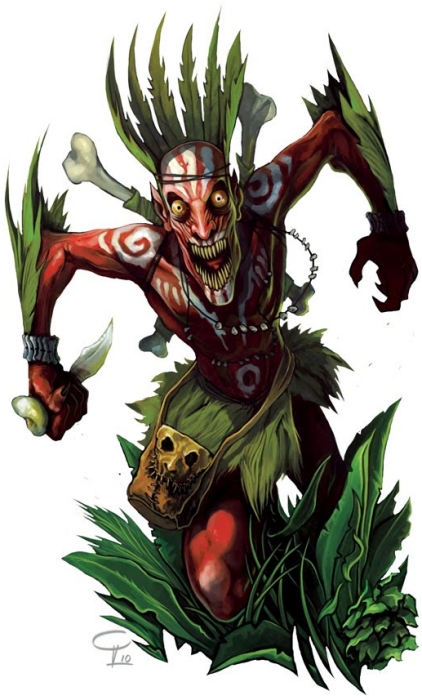 Of other forest creatures, the Yumboes are silver-haired white dwarves who care for a chosen family and grieve whenever something bad happens. The Wokulo of Mali are hairy, 3ft high mostly invisible creatures who steal food, and are strong enough to defeat the most powerful wrestlers. The hairless, grass-covered, sharp-clawed Eloko of central Congo haunt the hunters and scare their hapless wives, often eating their victims. The Aziza of Dahomey are their benevolent counterparts: tiny, hairy, living in anthills, smoking long pipes and providing white magic and spiritual advice for the hunters. Finally, there’s the Egbere fairy, with its precious sleeping mat – take it away, and it will follow you everywhere, wailing.
Of other forest creatures, the Yumboes are silver-haired white dwarves who care for a chosen family and grieve whenever something bad happens. The Wokulo of Mali are hairy, 3ft high mostly invisible creatures who steal food, and are strong enough to defeat the most powerful wrestlers. The hairless, grass-covered, sharp-clawed Eloko of central Congo haunt the hunters and scare their hapless wives, often eating their victims. The Aziza of Dahomey are their benevolent counterparts: tiny, hairy, living in anthills, smoking long pipes and providing white magic and spiritual advice for the hunters. Finally, there’s the Egbere fairy, with its precious sleeping mat – take it away, and it will follow you everywhere, wailing.
Not all forest dwellers are diminutive; the terrible Yehwe Zogbanu of Dahomey is an ogre-sized giant, with thirty horns on his head and body.
Rivers and Tricksters
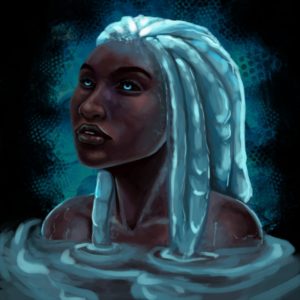 The rivers of West Africa are dangerous, too: in Nigeria live the Ikaki, human-slaying water spirits of Nigeria, taking the shape of an evil tortoise; in Congo, you can meet the disease-spreading water nymphs, Bisimbi Bi Masa, who are so dangerous only the bravest hunters and witch doctors dare to enter their abode.
The rivers of West Africa are dangerous, too: in Nigeria live the Ikaki, human-slaying water spirits of Nigeria, taking the shape of an evil tortoise; in Congo, you can meet the disease-spreading water nymphs, Bisimbi Bi Masa, who are so dangerous only the bravest hunters and witch doctors dare to enter their abode.
A separate breed of mythical creatures are the tricksters: often taking the shape of a particular animal, the tricksters are common to most cultures of the world; in West Africa, some of the most popular ones are Ngofariman, the cunning chimpanzee of Mali, and of course Anansi the Spider, originally from Ghana, now spread throughout the Caribbeans and USA, the favourite of children’s stories.
These are just some of the legendary creatures you can meet in the fantastic West Africa; there are many more, from wise talking oxes to smoke ghosts possessing tribal dancers. In the next instalment, I’ll be moving to the East and South – on a grand journey from the Cape of Good Hope to the Horn of Africa.
Next, we’ll be looking at Eastern and Southern African creatures.
Title image by Francesco Francavilla.


Awesome article! A great read.
Great article, looking forward to the next one.
[…] This is the second article in our Creatures in the Shadows series. You can read the first one on West African creatures here. […]
[…] One – West Africa Part Two – South and East […]
Good job ! Thanks !
[…] Creatures from West Africa […]
[…] James Calbraith has started a new series on less-familiar (to North Americans) mythologies over at Fantasy Faction. Check out the first installment, which deals with a number of creatures from West Africa: […]
[…] 8. Fantasy Faction – The Creatures in the Shadows: West Africa. Czyli o wampirach, wodnych demonach i innych potworach z mitologii i legend ludów wschodniej Afryki. […]
What sources did you use for this series of articles?
Thank you for article. Any GOOD spirited nature faeries you’ve studied from the african origin? Would love to read more!